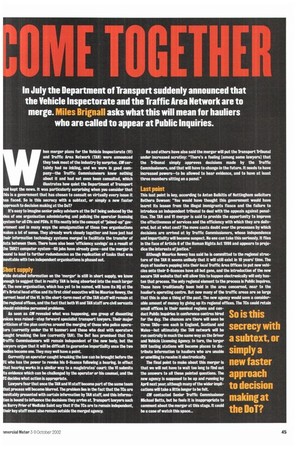F I GET
Page 45

If you've noticed an error in this article please click here to report it so we can fix it.
FR
In July the Department of Transport suddenly announced that the Vehicle Inspectorate and the Traffic Area Network are to merge. Miles Brignall asks what this will mean for hauliers who are called to appear at Public Inquiries.
hen merger plans for the Vehicle Inspectorate (Wi) and Traffic Area Network (TAN) were announced they took most of the industry by surprise. CM certainly had no inkling, and we were in good company—the Traffic Commissioners knew nothing about it and had not even been consulted, which illustrates how quiet the Department of Transport d kept the news. It was particularly surprising when you consider that s is a government that has chosen to consult on virtually every issue it faced. So is this secrecy with a subtext, or simply a new faster roach to decision making at the DoT?
It's easy to imagine senior policy advisors at the DoT being seduced by the of one organisation administering and policing the operator licensing tern for all CVs and PSIfs. It fits neatly Into the concept of "joined-up" govment and in many ways the amalgamation of these two organisations a lot of sense. They already work closely together and have just had Information technology systems merged to facilitate the transfer of a between them. There have also been 'efficiency savings' as a result of TAN21 computer system-60 jobs have already gone—and the merger is to lead to further redundancies as the replication of tasks that was • able with two independent organisations is phased out.
Ile detailed information on the 'merger is still in short supply, we know to suggest that in reality TAN is being absorbed into the much larger The new organisation, which has yet to be named, will have its HQ at the 's Bristol head office and its first chief executive will be Maurice Newey, the head of the VI. In the short-term most of the TAN staff will remain at regional offices, and the fact that both VI and TAN staff are civil servants uld minimise personnel emblems.
As soon as CM revealed what was happening, one group of dissenting was raised—step forward specialist transport lawyers. Their major
• • ism of the plan centres around the merging of those who police opera(currently under the VI banner) and those who deal with operators ught breaking the law (currently TAN). The DoT has promised that the Mc. Commissioners will remain independent of the new body, but the wyers argue that it will be difficult to guarantee impartiality once the two ies become one. They may well have a point.
Currently an operator caught breaking the law can be brought before the who has the power to revoke his 0-licence following a hearing. In effect at hearing works in a similar way to a magistrates' court the 1/1 submits evidence which can be challenged by the operator or his counsel, and the decides what action S appropriate.
Lawyers fear that once the TAN and VI staff become part of the same team at process will become blurred. The problem lies lithe fact that the Mare • presented with certain information by TAN staff, and this intormais bound to influence the decisions they arrive at. Transport lawyers such Barry Prior of Wedlake Saint say that If the TCs are to remain independent, 'r key staff must also remain outside the merged agency.
lie and others have also said the merger will put the Transport Tribunal under increased scrutiny: "There's a feeling [among some lawyers] that the Tribunal simply approves decisions made by the Traffic Commissioners, and that will have to change in the future. It needs to have Increased powers—to be allowed to hear evidence, and to have at least three members sitting on a panel."
This last point is key, according to Anton Balkitis of Nottingham solicitors Rothera Dowson: You would have thought this government would have learnt Its lesson from the illegal immigrants fiasco and the failure to Introduce an independent tribunal to deal with the appeals against penalties. The TAN and VI merger is said to provide the opportunity to improve the effectiveness of services and the efficiency with which they are delivered, but at what cost? The move casts doubt over the processes by which decisions are arrived at by Traffic Commissioners, whose independence and impartiality will become suspect. No one can take this seriously. It flies In the face of Article 6 of the Human Rights Act 1998 and appears to prejudice the interests of Justice."
The final point to make about this merger Is that we will not have to wait too long to find out the answers to an those pointed questions. The new agency is supposed to be up and running by April next year, although many of the wider implications will take a little longer to be felt.
CM contacted Senior Traffic Commissioner Michael Betts, but he feels it is inappropriate to comment about the merger at this stage. It could be a case of watch this space...




























































































































































